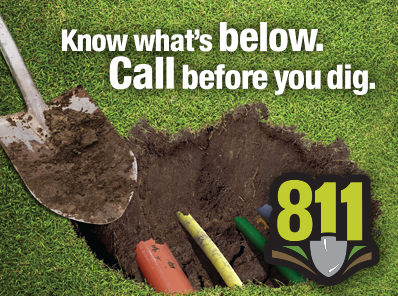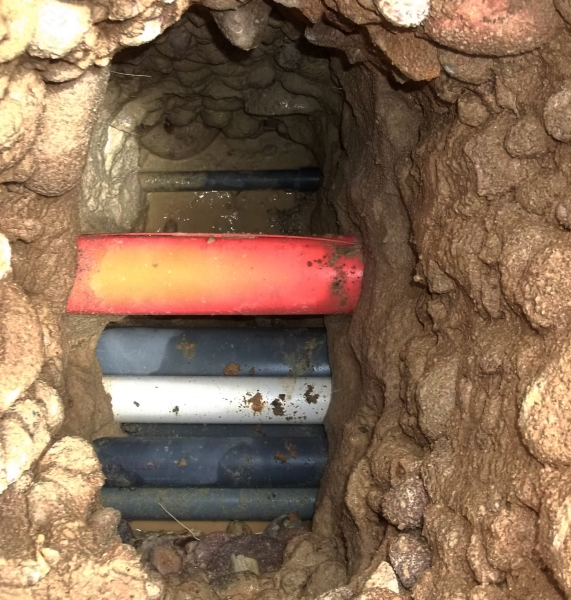Replacing underground utilities is a complex process. Whenever excavating or digging into the ground is required, it’s critical to understand exactly where buried utility lines are located – in order to avoid causing serious damage to underground infrastructure on your property. Here’s what you need to know before digging.
What Are Underground Utilities?
The term “utility” refers to the services provided by public utility companies, including electricity, natural gas, water, sewage, and telephone lines.
“Underground utilities” refers to subterranean infrastructure like pipes and cables that transport water, gas, telecommunications, and electricity to households and businesses. There are nearly two million miles of underground utilities in the United States, which equates to over one hundred years of underground line per person in the entire country.
Whenever digging into the ground, it’s imperative to locate underground utility lines on the site before penetrating the surface. Identifying and marking underground public utility lines is known as “utility location.” While privately owned lines are generally the responsibility of the landowner (this may include natural gas lines, private sewer laterals, sprinkler systems as well as electricity and telecom lines), underground utilities are usually the responsibility of public utility companies and homeowner. Utility companies will send a technician to visit the property and mark the location of all underground utility lines. This process free of charge in most municipalities. Contact your local utility providers to request underground location services..
What Is the Color Coding System for Underground Utility Lines?
In the United States, the American Public Works Association (APWA) has established Uniform Color Codes for temporary marking of underground utilities. Onsite technicians apply color codes using paint, chalk, stakes, or flags to indicate the locations and route of various underground utility lines. This standardized color coding system helps contractors, excavators, utility companies, municipalities – or anyone else working on or near underground infrastructure – facilities avoid accidents and damage to water, electricity, or internet supply.
The owners of public lines are responsible for marking the location of underground utilities near a job site, in accordance with the color coding standard:
| Red | Electric power lines, cables, conduit, and lighting cables |
| Orange | Telecommunication, alarm or signal lines, cables, or conduit |
| Yellow | Natural gas, oil, steam, petroleum, or other gaseous or flammable material |
| Green | Sewers and drain lines |
| Blue | Drinking water |
| Purple | Reclaimed water, irrigation, and slurry lines |
| Pink | Temporary survey markings, unknown/unidentified facilities |
| White | Proposed excavation limits or route |
Note: if you plan to dig within a small section of your yard, you can demarcate that area so that the entire property doesn’t need to be painted and marked up.
Once utility lines have been marked, the markings are generally valid only for a certain number of days (28 is typical) – because over time the markings become less visible, in addition to the fact that erosion and root growth can alter the depth and path of buried lines over time. Be sure to complete digs within this scope of time after marking.
What Are the Hazards of Replacing Underground Utilities?
According to the Common Ground Alliance, an underground utility line is damaged once every 6 minutes nationwide, because someone dug into the ground without understanding the location of underground lines. While these mistakes are often caused by large excavation projects, a simple mailbox installation or even a small gardening project can sometimes lead to a breach of underground utility lines.

“Call before you dig” advertisements are seemingly omnipresent these days. This is for good reason: it’s crucial to request a utility line inspector who can help you avoid costly and potentially dangerous damage to buried utility lines. In addition to causing service outages or damage to utilities, failing to properly prepare can put you at great risk of injury, electrocution, or worse: a natural gas line rupture that can result in dangerous explosions.
In many jurisdictions, it’s also a legal requirement to notify the public utility before any digging or excavation. Most locator services require a service request at least two days before beginning a digging project.
Fortunately, contacting your public utility is easy. In 2007, a universal N11 phone number was established for contacting the appropriate utility from 71 regional services that coordinate underground public utility locations. But instead of searching for the contact information for each individual utility, you can now simply dial 811. For more information, visit call811.com.
Contact a Local Licensed Professional
Although hidden from view, underground utility lines are a critical part of basic infrastructure. If you’re planning an expansion or require digging for any other reason, choosing a proper permitted and licensed professional will ensure that any excavation in the public right-of-way is completed responsibly and in accordance with code.
As professional sewer line repair and replacement technicians, we at Pipe Spy ensure any work we perform on your property is preceded by all public utility lines being marked, regardless if the utilities are privately or publicly managed. We are certified in Pipeline Assessment by NASSCO, and as early trenchless sewer replacement advocates, we have played a role in the sustainable transformation of local water utility infrastructure in the Oakland and Easy Bay region.
Contact a Pipe Spy professional for more information.

